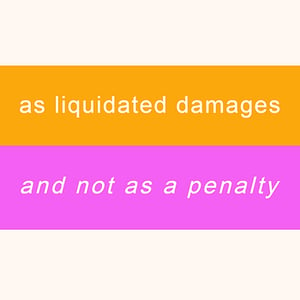Contract Concepts: Saying That an Amount Constitutes Liquidated Damages and Not a Penalty
 [This is the first in an occasional series that explores interesting issues in contract language. What distinguishes posts in this series from our This Sifter Matters series is simply that in this series, what’s discussed isn’t quite as much of a hot-button issue. This post is by our intern David Zukowski, who is so competent and personable he risks making Ken Adams look bad.]
[This is the first in an occasional series that explores interesting issues in contract language. What distinguishes posts in this series from our This Sifter Matters series is simply that in this series, what’s discussed isn’t quite as much of a hot-button issue. This post is by our intern David Zukowski, who is so competent and personable he risks making Ken Adams look bad.]
Vice Chancellor Laster of the Delaware Court of Chancery has a big fan club around here. Our chief content officer, Ken Adams, is club president.
When Laster isn’t busy dropping epic opinions (like the one discussed here) from the most influential business-law court in the United States, he somehow finds time for extracurriculars. Among other things, he wrote the foreword to Ken’s book A Manual of Style for Contract Drafting (go here for a copy of the foreword). And more relevantly for purposes of this post, he co-authored with Ken an article that explores how drafters in effect attempt to preempt judicial discretion.
Generally, it’s unpromising to try to tell courts what they should do, so it would be best if drafters were aware of when they’re doing that. But this approach is so prevalent that we suspect that most drafters are oblivious to the implications. A good example of that is provisions saying that a given amount of money constitutes liquidated damages and not a penalty.
Here’s an example (emphasis added):
The Parties acknowledge that the Development Rights Assignment is intended not as a penalty, but as full compensation and liquidated damages, in the event of a default or Failure to Close.
But saying that an amount is not a penalty doesn’t make it so—that’s for a court to decide as part of the process of deciding whether an amount constitutes liquidated damages. If parties dispute whether an amount is a penalty, the judge will likely pay little or no attention to what the contract calls it and consider the issue objectively.
How do courts go about doing that? The UCC and the Restatement (Second) of Contracts both directly address the validity of liquidated damages and they see things basically the same way.
Here’s what UCC § 2-718 says: (1) Damages for breach by either party may be liquidated in the agreement but only at an amount which is reasonable in the light of the anticipated or actual harm caused by the breach …. A term fixing unreasonably large liquidated damages is void as a penalty.
And here’s section 356 of the Restatement:
(1) Damages for breach by either party may be liquidated in the agreement but only at an amount that is reasonable in the light of the anticipated or actual loss caused by the breach and the difficulties of proof of loss. A term fixing unreasonably large liquidated damages is unenforceable on grounds of public policy as a penalty.
If having the parties say an amount is not a penalty gets you anything, it’s not much. Courts find unreasonably large liquidated damages unenforceable, regardless of whether the contract says they’re not a penalty. The comments to the Restatement give a test for whether an amount of damages is reasonable or a penalty. Reasonableness depends on the interplay of two factors: (1) the anticipated or actual loss caused by the breach and (2) difficulty in proving loss. To be reasonable, liquidated damages should either compensate for anticipated or actual losses or for losses that would be difficult or impossible to prove.
So to increase the likelihood of a court finding a liquidated-damages provision enforceable, say what kind of losses they are compensating for and explain how the liquidated damages amount was calculated. If damages are difficult to estimate, explain why—picture your high school math teacher admonishing you to show your work. You’ll get no points for unsupported conclusions; top marks if you guide the court to a logical conclusion that liquidated damages are reasonable.
On behalf of the Vice Chancellor Laster fan club, we humbly ask you to review your liquidated damages provisions and consider some changes to make his life—and yours!—a little easier. The guy has a lot going on!
And we know you who work with contracts have a lot going on too. The Sifter Liquidated Damages: Not a Penalty, like LegalSifter Review®️ generally, saves you time, helps you make informed decisions, and reduces the risk of unpleasant surprises. It looks for not-a-penalty language, and it tells users the implications.
